Hydrodynamics of the Instream Flow Environment of a Gravel-Bed River
Abstract
1. Introduction
2. Materials and Methods
2.1. Study Site
2.2. Field Methods
2.3. Calculations
3. Results
4. Discussion
5. Conclusions
Author Contributions
Funding
Institutional Review Board Statement
Informed Consent Statement
Data Availability Statement
Acknowledgments
Conflicts of Interest
References
- Harvey, G.; Clifford, N. Microscale Hydrodynamics and Coherent Flow Structures in Rivers: Implications for the Characterization of Physical Habitat. River Res. Appl. 2009, 180, 160–180. [Google Scholar] [CrossRef]
- Kownacki, A.; Soszka, H. Wytyczne do Oceny Stanu Rzek na Podstawie Makrobezkręgowców Oraz do Pobierania Prób Makrobezkręgowców w Jeziorach; IOŚ: Warszawa, Poland, 2004. [Google Scholar]
- Mouton, A.M.; Schneider, M.; Depestele, J.; Goethals, P.L.M.; De Pauw, N. Fish Habitat Modelling as a Tool for River Management. Ecol. Eng. 2007, 29, 305–315. [Google Scholar] [CrossRef]
- Książek, L.; Bartnik, W. Wykorzystanie warunków hydraulicznych do oceny typów siedlisk w korycie rzecznym. Nauk. Przyr. Technol. 2009, 3, 89. [Google Scholar]
- Clifford, N.J.; Harmar, O.P.; Harvey, G.; Petts, G.E. Physical Habitat, Eco-Hydraulics and River Design: A Review and Re-Evaluation of Some Popular Concepts and Methods. Aquat. Conserv. Mar. Freshw. Ecosyst. 2006, 16, 389–408. [Google Scholar] [CrossRef]
- Harper, D.; Everard, M. Why Should the Habitat—Level Approach Underpin Holistic River Survey and Management? Aquat. Conserv. Mar. Freshw. Ecosyst. 1998, 8, 395–413. [Google Scholar] [CrossRef]
- Jowett, I.G. A Method for Objectively Identifying Pool, Run, and Riffle Habitats from Physical Measurements. N. Z. J. Mar. Freshw. Res. 1993, 27, 241–248. [Google Scholar] [CrossRef]
- Cardinale, B.; Palmer, M.; Swan, C. The Influence of Substrate Heterogeneity on Biofilm Metabolism in a Stream Ecosystem. Ecology 2002, 83, 412–422. [Google Scholar] [CrossRef]
- Roy, M.; Roy, A.; Legendre, P. The Relations between “standard” Fluvial Habitat Variables and Turbulent Flow at Multiple Scales in Morphological Units of a Gravel-bed River. River Res. Appl. 2010, 26, 439–455. [Google Scholar] [CrossRef]
- Enders, E.C.; Roy, M.L.; Ovidio, M.; Hallot, É.J. Habitat Choice by Atlantic Salmon Parr in Relation to Turbulence at a Reach Scale. N. Am. J. Fish. Manag. 2009, 29, 1819–1830. [Google Scholar] [CrossRef]
- Lupandin, A.I. Effect of Flow Turbulence on Swimming Speed of Fish. Izv. Akad. Nauk Ser. Biol. 2005, 32, 558–565. [Google Scholar] [CrossRef]
- Smith, D.L.; Brannon, E.L.; Odeh, M. Response of Juvenile Rainbow Trout to Turbulence Produced by Prismatoidal Shapes. Trans. Am. Fish. Soc. 2005, 134, 741–753. [Google Scholar] [CrossRef]
- Smith, D.L.; Brannon, E.L. Influence of Cover on Mean Column Hydraulic Characteristics in Small Pool Riffle Morphology Streams. River Res. Appl. 2007, 23, 125–139. [Google Scholar] [CrossRef]
- Roy, A.G.; Buffin-Blanger, T.; Lamarre, H.; Kirkbride, A.D. Size, Shape and Dynamics of Large-Scale Turbulent Flow Structures in a Gravel-Bed River. J. Fluid Mech. 2004, 500, 1–27. [Google Scholar] [CrossRef]
- Tritico, H.M.; Hotchkiss, R.H. Unobstructed and Obstructed Turbulent Flow in Gravel Bed Rivers. J. Hydraul. Eng. 2005, 131, 635–645. [Google Scholar] [CrossRef]
- Lamarre, H.; Roy, A.G. Reach Scale Variability of Turbulent Flow Characteristics in a Gravel-Bed River. Geomorphology 2005, 68, 95–113. [Google Scholar] [CrossRef]
- Legleiter, C.J.; Phelps, T.L.; Wohl, E.E. Geostatistical Analysis of the Effects of Stage and Roughness on Reach-Scale Spatial Patterns of Velocity and Turbulence Intensity. Geomorphology 2007, 83, 322–345. [Google Scholar] [CrossRef]
- Bisson, P.; Montgomery, D.; Buffington, J. Valley segments, stream reaches, and channel units. In Methods in Stream Ecology; Richard, H., Gary, L., Eds.; Elsevier: London, UK, 1996; pp. 23–50. [Google Scholar]
- Parasiewicz, P. The MesoHABSIM Model Revisited. River Res. Appl. 2007, 23, 893–903. [Google Scholar] [CrossRef]
- Sukhodolov, A.; Thiele, M.; Bungartz, H. Turbulence Structure in a River Reach with Sand Bed. Water Resour. Res. 1998, 34, 1317–1334. [Google Scholar] [CrossRef]
- Holmes, R.R. Surface water data collection. In Field Methods for Hydrologic and Environmental Studies; Harris, M., Ed.; US Geological Survey: Urbana, IL, USA, 2001; pp. 1–77. [Google Scholar]
- Kinzel, P.J.; Wright, C.W.; Nelson, J.M.; Burman, A.R. Evaluation of an Experimental LiDAR for Surveying a Shallow, Braided, Sand-Bedded River. J. Hydraul. Eng. 2007, 133, 838–842. [Google Scholar] [CrossRef]
- David, G.C.L.; Legleiter, C.J.; Wohl, E.; Yochum, S.E. Characterizing Spatial Variability in Velocity and Turbulence Intensity Using 3-D Acoustic Doppler Velocimeter Data in a Plane-Bed Reach of East St. Louis Creek, Colorado, USA. Geomorphology 2013, 183, 28–44. [Google Scholar] [CrossRef]
- Wilcox, A.C.; Wohl, E.E. Field Measurements of Three-Dimensional Hydraulics in a Step-Pool Channel. Geomorphology 2007, 83, 215–231. [Google Scholar] [CrossRef]
- Buffin-Bélanger, T.; Roy, A.G. 1 Min in the Life of a River: Selecting the Optimal Record Length for the Measurement of Turbulence in Fluvial Boundary Layers. Geomorphology 2005, 68, 77–94. [Google Scholar] [CrossRef]
- Martin, V.; Fisher, T.; Millar, R.; Quick, M. ADV Data analysis for turbulent flows: Low correlation problem (ASCE). In Hydraulic Measurements and Experimental Methods 2002; Wahl, T.L., Pugh, C.A., Oberg, K.A., Vermeyen, T.B., Eds.; American Society of Civil Engineers: Estes Park, CO, USA, 2002; pp. 1–10. [Google Scholar]
- Goring, D.; Nikora, V. Despiking Acoustic Doppler Velocimeter Data. J. Hydraul. Eng. 2002, 128, 117–126. [Google Scholar] [CrossRef]
- Wahl, T.L. Discussion of “Despiking Acoustic Doppler Velocimeter Data” by Derek, G. Goring and Vladimir, I. Nikora. J. Hydraul. Eng. 2002, 128, 484–488. [Google Scholar] [CrossRef]
- Trinci, G.; Harvey, G.L.; Henshaw, A.J.; Bertoldi, W.; Hölker, F. Life in Turbulent Flows: Interactions between Hydrodynamics and Aquatic Organisms in Rivers. Wiley Interdiscip. Rev. Water 2017, 4, e1213. [Google Scholar] [CrossRef]
- Stone, M.C.; Hotchikiss, R.H. Turbulence Descriptions in Two Cobble-Bed River Reaches. J. Hydraul. Eng. 2007, 133, 1367–1378. [Google Scholar] [CrossRef][Green Version]
- Brylińska, M. Ryby Słodkowodne Polski; Wydawnictwo Naukowe PWN: Warszawa, Poland, 1991. [Google Scholar]
- Abel, S.; Hopkinson, C.; Hession, W. Hydraulic and Physical Structure of Runs and Glides Following Stream Restoration. River Res. Appl. 2016, 32, 1890–1901. [Google Scholar] [CrossRef]
- Tritico, H.M. The Effects of Turbulence on Habitat Selection and Swimming Kinematics of Fishes. Ph.D. Thesis, University of Michigan, Ann Arbor, MI, USA, 2009. [Google Scholar]
- Nikora, V.; Green, M.O.; Thrush, S.F.; Hume, T.M.; Goring, D. Structure of the Internal Boundary Layer over a Patch of Pinnid Bivalves (Atrina Zelandica) in an Estuary. J. Mar. Res. 2002, 60, 121–150. [Google Scholar] [CrossRef]
- Reid, M.A.; Thoms, M.C. Surface Flow Types, near-Bed Hydraulics and the Distribution of Stream Macroinvertebrates. Biogeosciences 2008, 5, 1043–1055. [Google Scholar] [CrossRef]
- Wilkes, M.A.; Maddock, I.A.N.; Acreman, M.C. A Hydrodynamic classification of mesohabitats. In Proceedings of the 10th International Symposium on Ecohydraulics, Trondheim, Norway, 21–27 June 2014. [Google Scholar] [CrossRef]
- Nikora, V.; Aberle, J.; Biggs, B. Effects of Fish Size, Time to Fatigue and Turbulence on Swimming Performance: A Case Study of Galaxias Maculatus. J. Fish Biol. 2003, 63, 1365–1382. [Google Scholar] [CrossRef]
- Nikora, V.I.; Goring, D.G.; Biggs, B.J.F. On Stream Periphyton-Turbulence Interactions. N. Z. J. Mar. Freshw. Res. 1997, 31, 435–448. [Google Scholar] [CrossRef]
- Silva, A.T.; Santos, J.M.; Ferreira, M.T.; Pinheiro, A.N.; Katopodis, C. Effects of Water Velocity and Turbulence on the Behaviour of Iberian Barbel (Luciobarbus bocagei, Steindachner 1864) in an experimental pool-type fishway. River Res. Appl. 2011, 27, 360–373. [Google Scholar] [CrossRef]
- Mosley, M. A Procedure for characterising river channels. In Water and Soil Miscellaneous Publication; Ministry of Works and Development: Wellington, New Zealand, 1982; Volume 32, p. 90. [Google Scholar]
- Allen, K.R. The Horokiwi Stream: A Study of Trout Population. Fish. Bull. 1951, 10, 231. [Google Scholar]
- Kemp, J.L.; Harper, D.M.; Crosa, G.A. The Habitat-Scale Ecohydraulics of Rivers. Ecol. Eng. 2000, 16, 17–29. [Google Scholar] [CrossRef]
- Moir, H.J.; Pasternack, G.B. Relationships between Mesoscale Morphological Units, Stream Hydraulics and Chinook Salmon (Oncorhynchus Tshawytscha) Spawning Habitat on the Lower Yuba River, California. Geomorphology 2008, 100, 527–548. [Google Scholar] [CrossRef]
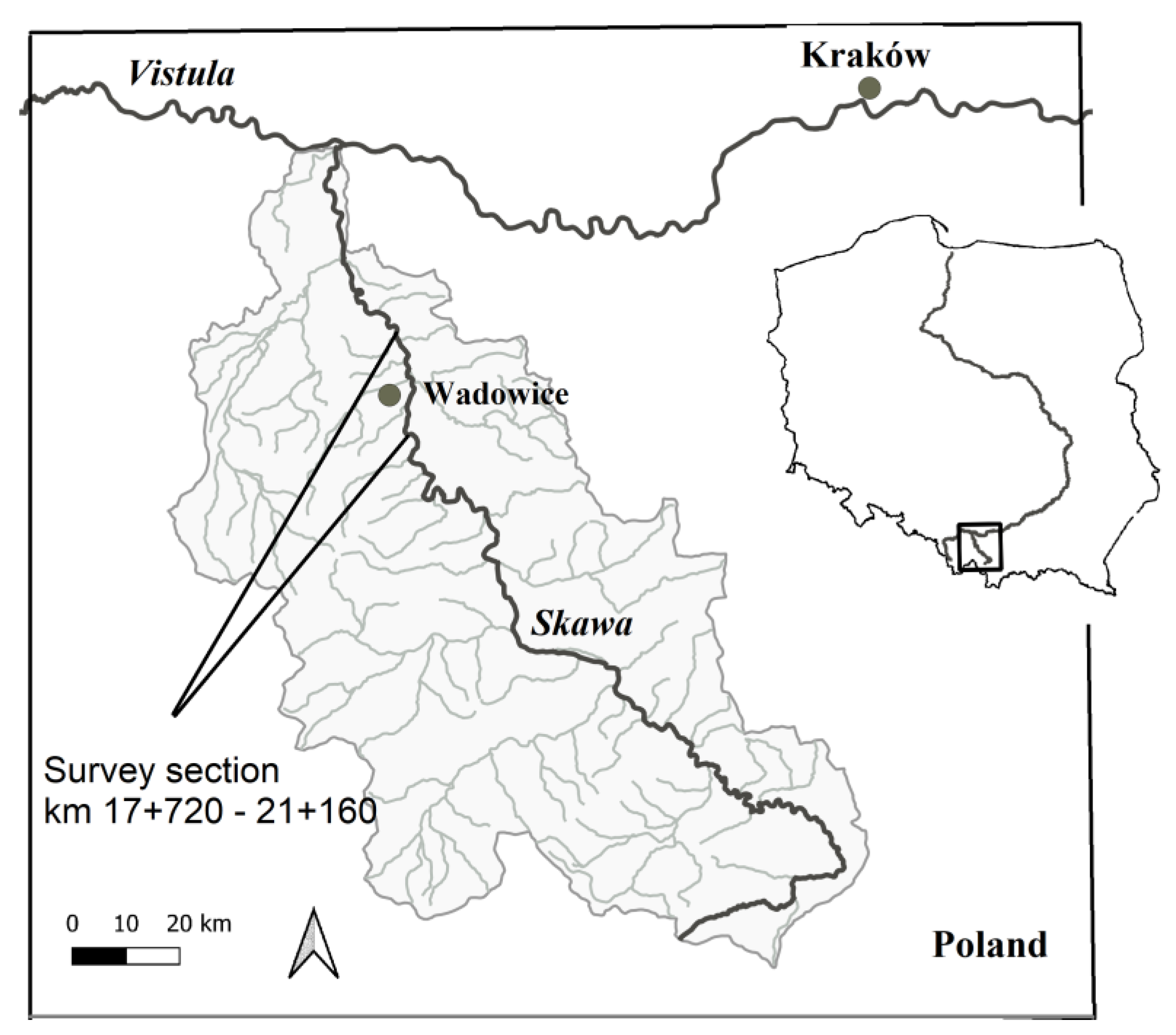
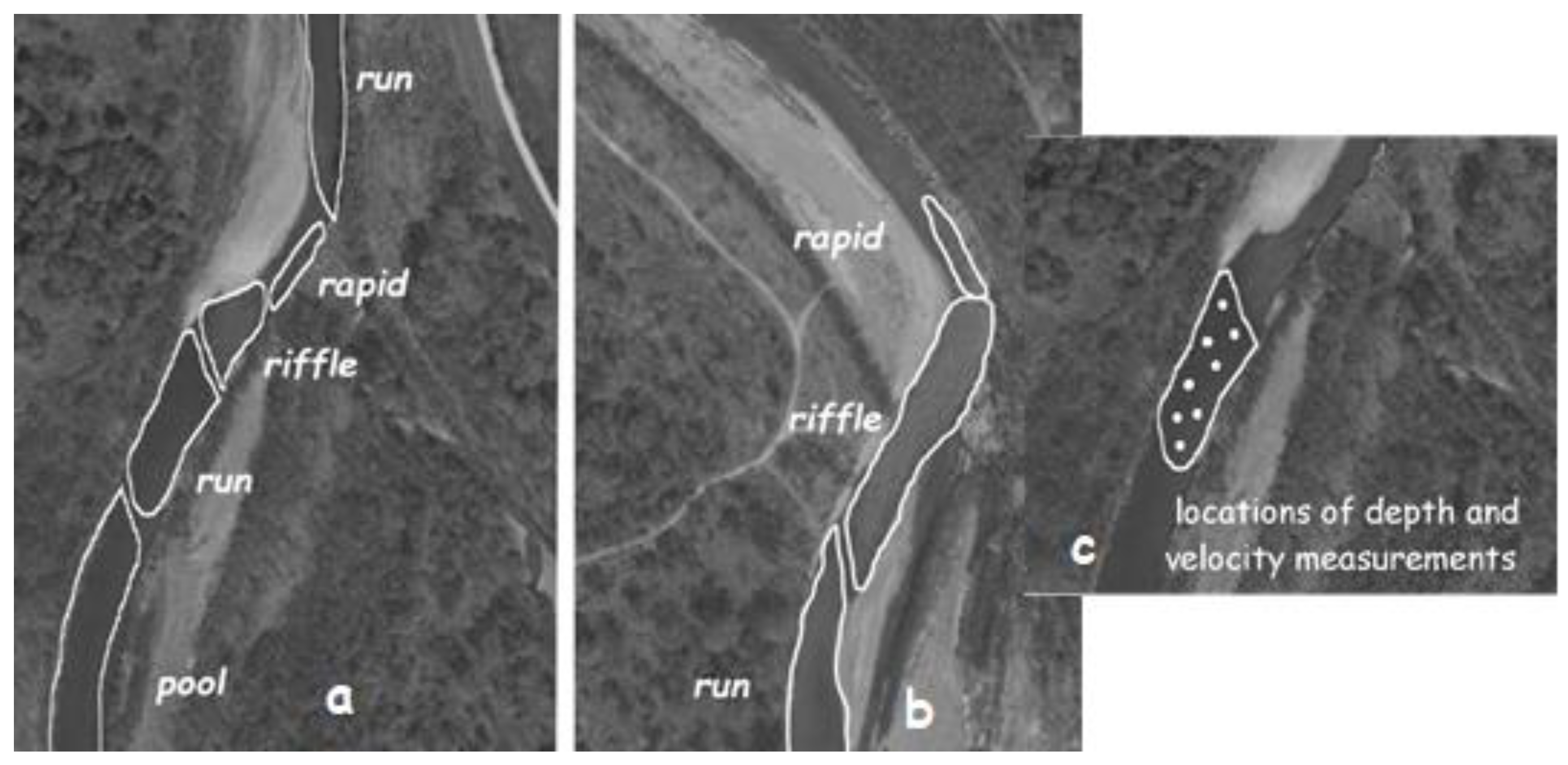

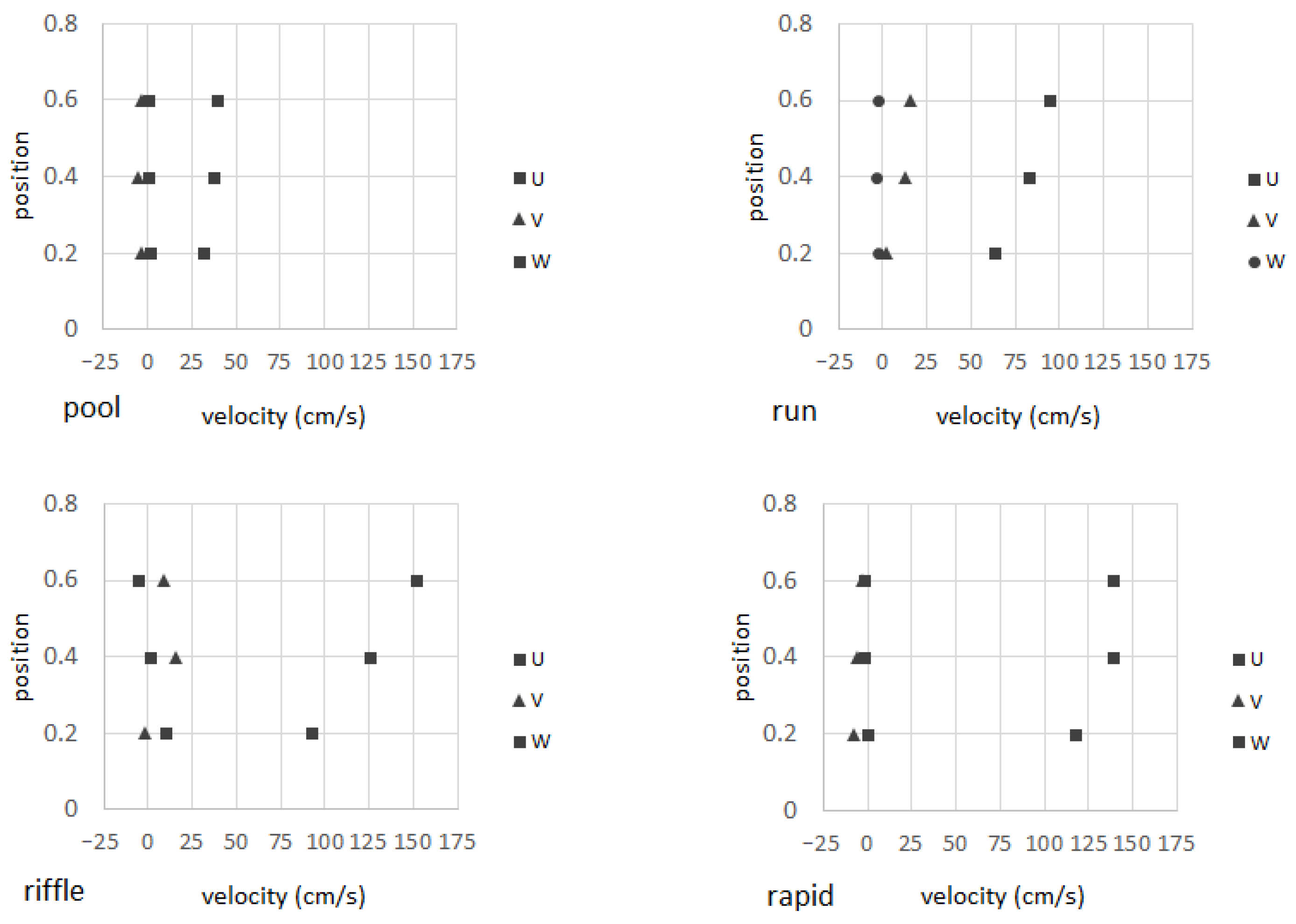
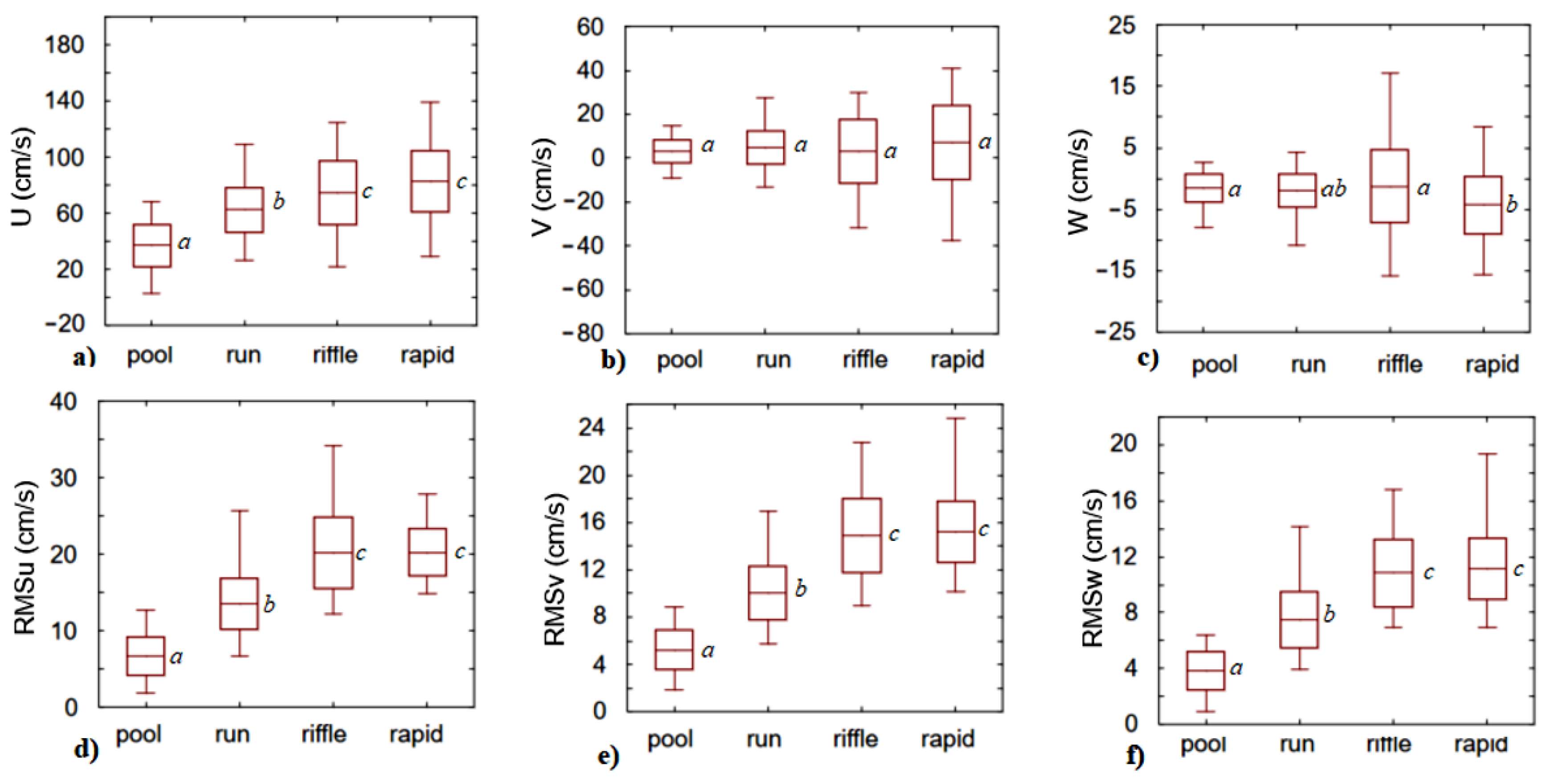



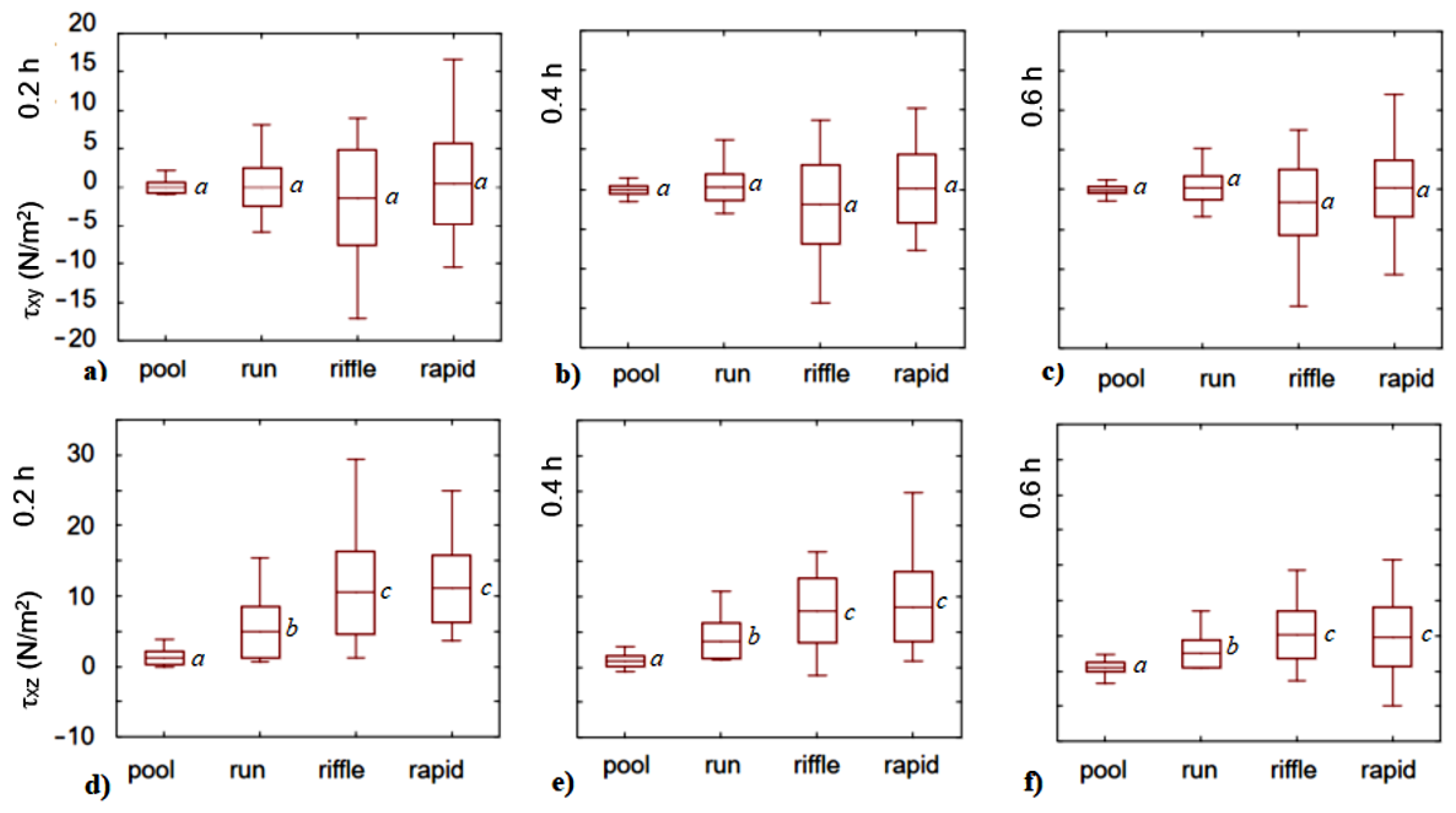
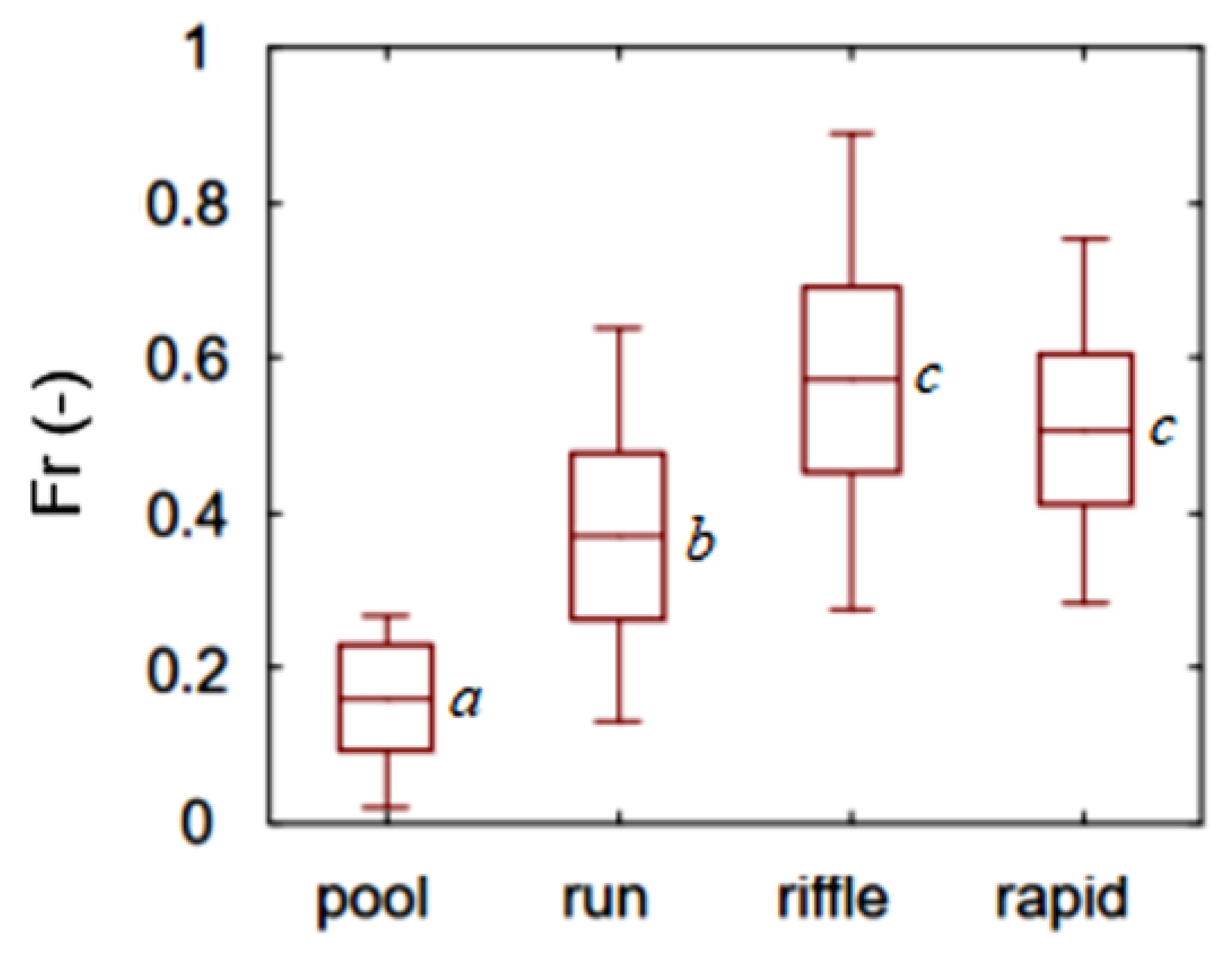
| Hydromorphological Unit | Description |
|---|---|
| Pool | A channel segment with a concave longitudinal profile, high depth, slow water flow and smooth water surface Hydraulic summary: deep and slow flow |
| Run | A monotonous channel segment with a well-defined thalweg, moderate velocity and moderate depth, ripples or traveling waves on the water surface Hydraulic summary: medial depth and medial flow velocity |
| Riffle | A shallow area with fast current velocity and strong turbulence on the surface visible as standing unbroken or broken waves Hydraulic summary: shallow and fast flow |
| Rapid | A high gradient morphological form with very fast current velocity and turbulence on the water surface (standing waves), usually occurs downstream of a riffle Hydraulic summary: medial depth and fast flow |
| Sampling Position | Pools | Runs | Riffles | Rapids |
|---|---|---|---|---|
| 0.2 h | 64 | 63 | 67 | 56 |
| 0.4 h | 64 | 63 | 71 | 55 |
| 0.6 h | 64 | 63 | 70 | 53 |
| Variable | Sampling Position | Pools | Runs | Riffles | Rapids |
|---|---|---|---|---|---|
| Depth (cm) | 85.1 (54) a1 | 53.2 (32) b | 35.8 (20) c | 53.2 (38) b | |
| Magnitude velocity Muvw (cm2·s−1) | 0.2 h | 38.2 (3.4) a | 64.4 (27.1) b | 79.3 (27.6) c | 87.8 (36.5) c |
| 0.4 h | 45.6 (5.4) a | 81.7 (34.3) b | 106.6 (54.5) c | 115.1 (63.9) c | |
| 0.6 h | 49.2 (8.5) a | 91.9 (38.2) b | 121.6 (65.3) c | 131.4 (78.9) c |
| TKE Component | Sampling Position | Pools | Runs | Riffles | Rapids |
|---|---|---|---|---|---|
| TKE_u | 51 (35) | 53 (34) | 54 (40) | 54 (26) | |
| TKE_v | 0.2 h | 32 (18) | 30 (22) | 30 (22) | 30 (21) |
| TKE_w | 17 (9) | 17 (12) | 16 (11) | 16 (11) | |
| TKE_u | 51 (32) | 52 (43) | 54 (35) | 54 (41) | |
| TKE_v | 0.4 h | 32 (20) | 30 (23) | 30 (22) | 29 (19) |
| TKE_w | 17 (10) | 18 (13) | 16 (11) | 17 (11) | |
| TKE_u | 48 (34) | 52 (40) | 55 (43) | 53 (41) | |
| TKE_v | 0.6 h | 33 (18) | 30 (23) | 29 (22) | 30 (21) |
| TKE_w | 18 (9) | 18 (13) | 16 (10) | 17 (12) |
Publisher’s Note: MDPI stays neutral with regard to jurisdictional claims in published maps and institutional affiliations. |
© 2022 by the authors. Licensee MDPI, Basel, Switzerland. This article is an open access article distributed under the terms and conditions of the Creative Commons Attribution (CC BY) license (https://creativecommons.org/licenses/by/4.0/).
Share and Cite
Woś, A.; Książek, L. Hydrodynamics of the Instream Flow Environment of a Gravel-Bed River. Sustainability 2022, 14, 15330. https://doi.org/10.3390/su142215330
Woś A, Książek L. Hydrodynamics of the Instream Flow Environment of a Gravel-Bed River. Sustainability. 2022; 14(22):15330. https://doi.org/10.3390/su142215330
Chicago/Turabian StyleWoś, Agnieszka, and Leszek Książek. 2022. "Hydrodynamics of the Instream Flow Environment of a Gravel-Bed River" Sustainability 14, no. 22: 15330. https://doi.org/10.3390/su142215330
APA StyleWoś, A., & Książek, L. (2022). Hydrodynamics of the Instream Flow Environment of a Gravel-Bed River. Sustainability, 14(22), 15330. https://doi.org/10.3390/su142215330






